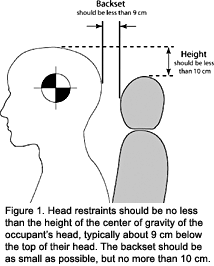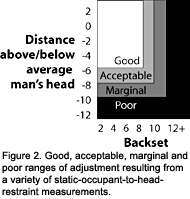New York's highest court of appeals has held that no-fault insurers cannot deny no-fault benefits where they unilaterally determine that a provider has committed misconduct based upon alleged fraudulent conduct. The Court held that this authority belongs solely to state regulators, specifically New York's Board of Regents, which oversees professional licensing and discipline. This follows a similar recent ruling in Florida reported in this publication.
Automobile Safety: A Public Health Issue of Special Interest to Chiropractors
Gerald Stevens, DC, MS, MPH, recently wrote an article on health promotion for this column. Dr. Stevens wrote about how chiropractors could use health promotion not only to provide community service, but also as a patient-recruitment tool.1 This article continues with that theme by suggesting a community or practice-level program that can be accomplished by an individual or by a group of chiropractors, such as a local society. Although many possible choices of projects are available, the program presented in this article involves educating patients and/or the community about certain aspects of automobile passenger safety (e.g., how to adjust child and infant seats, or head restraints) and can be carried out solely by chiropractors, or in conjunction with other organizations in the community. I discuss the need for such an event, provide links to implementation resources and suggest ways to carry it out.
Child Passenger Safety Inspection
Motor vehicle crashes (MVCs) are the leading cause of death for children 0 to 18 years of age. Indeed, 1,451 children age 14 and younger died in MVCs in the U.S. in 2005; about 203,000 were injured. In 2000, 10,306 children below the age of 18 were permanently disabled due to MVCs.2 The most tragic part about the widespread death and maiming of children in MVCs (one in which we as chiropractors should be vitally interested) is that almost half of these children were not restrained in any way.
The National Highway Traffic Safety Administration (NHTSA) has established Child Passenger Safety Inspection Stations throughout the United States at fire, police and highway patrol offices, as well as many auto dealerships.3 A comprehensive list of inspection stations can be found on the NHTSA Web site at: www.nhtsa.dot.gov/people/injury/childps/ CPSFittingStations/CPSinspection.htm. Each of the listed stations is staffed by nationally certified technicians and/or instructors. Some of these locations would no doubt be willing to cooperate with local chiropractors in setting up an automobile safety inspection event. Safe Kids USA (www.usa.safekids.org) maintains a list of state and local coalitions that also provide inspections and may become a valuable local contact.
Alternatively, individuals can become certified child-passenger safety (CPS) technicians through the National Standardized Child Passenger Safety Training Program. CPS training typically takes several days and costs several hundred dollars. However, only a few chiropractors from a practice group need to become certified. For information on how to attain certification, go to: www.safekids.org/certification. With some certified chiropractors, a group could then stage its own event and perform inspections independent of other organizations. One thing to keep in mind when planning an event that includes child restraint system (CRS) inspection is that typically, 30-45 minutes per seat is required.
Some may question the need for child-safety seat inspections. After all, the seats have to meet certain criteria in order to be sold, and they come with instructions. However, a study that examined the use of CRS in 3,442 automobiles revealed that one or more critical misuses were apparent 72.6 percent of the time.4 The worst misuse (83.9 percent of the time) was with infants and toddlers. Another study found CRS misuse to be common, with 95.6 percent of the seats inspected having at least one installation error.5
Vehicle Head Restraint Inspection

The Insurance Institute for Highway Safety (IIHS) has rated head restraints for production automobiles for years, based on static measurements of a crash-test dummy's head position with respect to the head restraint. Many head restraints received "poor" ratings in the early years of testing, but they have improved considerably in more recent tests. For example, 80 percent of models tested in 2004 attained "good" or "acceptable" ratings. However, suitable geometry for a dummy does not always translate into the best geometry for a human, especially when the head restraint is not adjusted properly in very tall people or those with abnormal spinal curvatures.

In addition to the static tests, the IIHS recently began performing dynamic head-restraint tests in which the seat to be tested and a crash-test dummy are suddenly thrust forward on a sled to simulate approximately a 20-mph rear-impact collision. Many of the models that previously had high static test scores performed poorly in this dynamic test. Moreover, 56 percent of the models tested dynamically in 2006 were assigned a "poor" score. Thus, when assessing the whiplash crash-worthiness of a given head restraint for a particular person, the data provided by both the static and dynamic tests must be considered.
The IIHS provides head-restraint ratings for most passenger vehicles on their Web site, free of charge (www.iihs.org). Click the "Vehicle Ratings" link and then scroll down the page to the "rear-crash protection/head-restraint ratings" to view this. According to the IIHS, good head-restraint geometry involves the restraint being behind and close to the back of an occupant's head. The restraint should be no less than the height of the center of gravity of the occupant's head, which is typically about 9 cm (3.5 inches) below the top of their head. The backset, or distance behind the head, should be as small as possible. Backsets of more than 10 cm (4 inches) have been associated with increased symptoms after whiplash.9 (See Figures 1 and 2.)
In addition to having a highly rated and properly adjusted head restraint, following are some suggestions that can be provided to people during inspections to help them prevent whiplash:
- Have them adjust their seatbacks to a more upright position. This typically brings the head restraint closer to the occupant's head, which reduces the backset and consequently the injury risk.
- Teach them how to adjust their head restraint. Studies have shown that only about 10 percent of occupants adjust them properly, even though about 80 percent are adjustable on U.S. vehicles. As a general rule, it should be raised to the top of the ears and, if possible, tilted forward to move it closer to the head.
These suggestions are applicable to drivers, as well as to passengers. An automobile safety event could also include other aspects of safety, such as vehicle inspection by a certified mechanic or vision testing by an optometrist. In addition to visual acuity, there are several aspects of vision that have been suggested as being necessary for safe driving which are not tested in state driving tests (e.g., dynamic acuity and contrast sensitivity). Also, reduced cervical range of motion (ROM) has been shown to be a risk factor for MVCs in elderly drivers,10 which could easily be tested by participating chiropractors. Keep in mind, however, that this risk factor may only be true in elderly drivers, since Hunter-Zaworski11 reported that younger drivers (ages 30-50) were able to compensate for reduced cervical ROM during a simulated traffic maneuver.
Implementing an Automobile Passenger Safety Event
An automobile passenger safety event is a worthy service to the community that can prevent a great deal of harm and even death. If done properly, it will elevate chiropractic in the eyes of the public, yet it is not that difficult to carry out. By simply implementing the points outlined in this article and contacting the provided resources, the event should come together with few problems. Following is a list of some action steps that are necessary to carry it out successfully:
- Decide whether outside organizations will be involved and, if so, make the appropriate contacts. Consider contacting the local chapter of Safe Kids USA.
- Line up participants (inspectors and other required personnel). If necessary, obtain certification for those who will do the CRS inspections.
- Set a date and a location. Keep in mind, the location must be capable of handling people, as well as their vehicles and increased traffic. Allocate sufficient time and personnel to handle the expected turnout.
- Advertise to patients within the participating chiropractic offices and/or the entire community. Advertising may be kept inexpensive and simple, such as flyers and posters, or more sophisticated, like newspaper and television ads.
- Prepare flyers and brochures to pass out during the event, such as the "Preventing Injuries to Children in Motor Vehicle Crashes" fact sheet that can be downloaded from the Safe Kids USA Web site.
- Enjoy the event and the good- will that it brings to you and the chiropractic profession!
Participation in these types of mainstream pubic-health activities is good for chiropractors and good for their community, and typifies our commitment to the APHA's vision of "Healthy People in Healthy Communities." For more information about the APHA and its Chiropractic Health Care Section, visit www.apha.org.
References
- Stevens GL. "Health Promotion: A Community Service and Patient-Recruitment Tool." Dynamic Chiropractic, 2007. www.chiroweb.com/archives/25/19/02.html.
- Facts About Injuries to Child Occupants in Motor Vehicle Crashes. Washington, DC: Safe Kids USA, 2007, pp. 1-3
- NHTSA, Child Passenger Safety Inspection Stations. Washington, DC: U.S. Department of Transportation, National Highway Traffic Safety Administration, 2007.
- Decina L, Lococo K, Block A. Misuse of Child Restraints: Results of a Workshop to Review Field Data Results. Washington, DC: National Highway Traffic Safety Administration, 2005, pp. 1-5.
- Stepanski BM, Ray LU, Nichols L. Booster seats: a community based study of installation and use by parents and caregivers. Annu Proc Assoc Adv Automot Med, 2001;45:37-48.
- Ratliff AH. Whiplash injuries. J Bone Joint Surg Br, 1997;79(4):517-9.
- Fockler SK, Vavrik J, Kristiansen L. Motivating drivers to correctly adjust head restraints: assessing effectiveness of three different interventions. Accid Anal Prev, 1998;30(6):773-80.
- Taylor SE. Health Psychology 3rd ed. New York: McGraw-Hill, 1995, p. 781.
- IIHS, Procedures for Rating Seat/Head Restraints. Arlington, VA: Insurance Institute for Highway Safety, 2007.
- Marottoli RA, Richardson ED, Stowe MH, et al. Development of a test battery to identify older drivers at risk for self-reported adverse driving events. J Am Geriatr Soc,1998;46(5):562-8.
- Hunter-Zaworski KM. T-intersection simulator performance of drivers with physical limitations. Transportation Research Record, 1990;1281:11-15.



